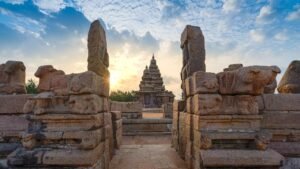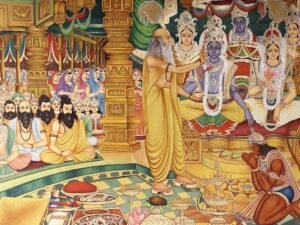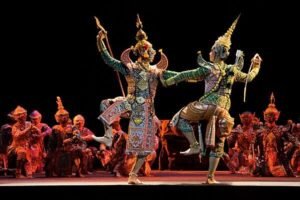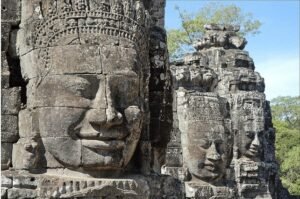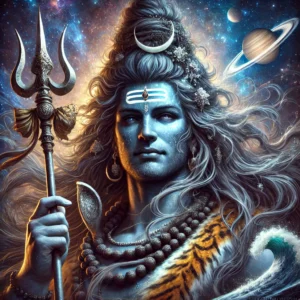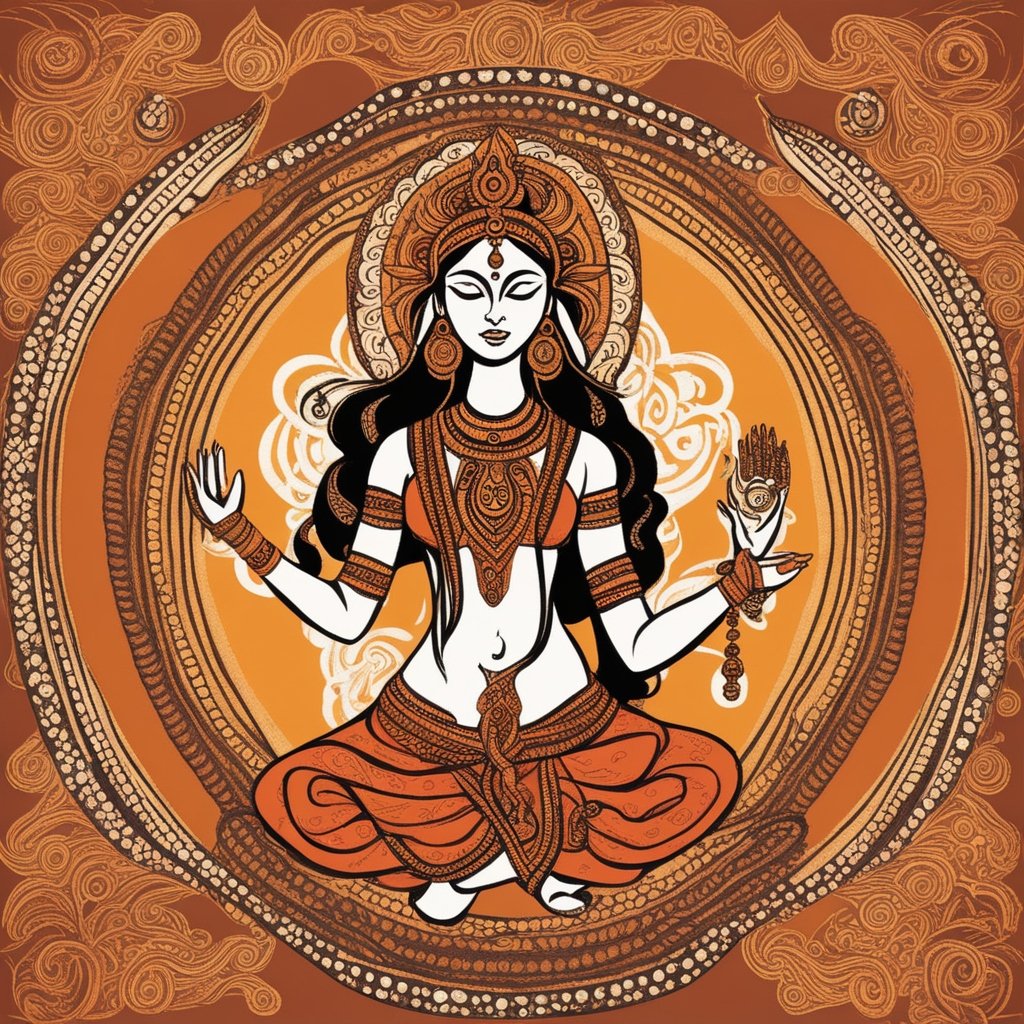
What are Shakti Peeths? Divine Seats of Goddess Shakti
Shakti Peeths are revered holy sites in Hinduism, dedicated to the Goddess Shakti, the Divine Feminine. These ancient temples are scattered across the Indian subcontinent, each dedicated to a manifestation of Goddess Shakti, the divine feminine power that drives creation and destruction.
These spiritual places hold immense religious significance, as they are believed to be the locations where different body parts of the goddess Sati fell when Lord Shiva carried her body across the earth after her self-immolation. According to Hindu mythology, there are 51 or 108 Shakti Peeths, though the number varies depending on the scriptures referenced. Each Shakti Peeth is associated with a specific body part of Sati, making it a place of deep spiritual power and devotion.
Story Behind the Establishment of Shakti Peeths
The origin of Shakti Peeths is rooted in one of the most famous and significant stories in Hindu mythology, recounting the tale of Goddess Sati and Lord Shiva. The Shakti Peeths are believed to have been established in places where parts of Sati’s body fell after a tragic event in her life. Here’s the story of how these sacred sites came into existence:
The Divine Marriage of Sati and Shiva
Goddess Sati, an incarnation of Goddess Shakti (the divine feminine energy), was the daughter of Daksha Prajapati, a powerful king and one of the sons of Brahma. Despite her father’s disapproval, Sati chose to marry Lord Shiva, the ascetic god who lived a simple, detached life on Mount Kailash.
Daksha never accepted this union because he considered Shiva to be unworthy of his royal lineage, given Shiva’s unconventional lifestyle as a yogi, who often roamed in forests and was not concerned with worldly status or possessions.
Daksha’s Yajna and Sati’s Immolation
To humiliate Shiva and assert his dominance, Daksha organized a grand yajna (a Vedic ritual sacrifice) but intentionally did not invite Lord Shiva or Sati. When Sati learned of the event, she felt deeply insulted by her father’s blatant disrespect towards her husband. Despite Shiva’s warnings, Sati decided to attend the yajna, hoping to confront her father.
Upon her arrival, Daksha continued to insult Shiva in front of the gathered guests. Unable to bear the insults directed at her beloved husband, Sati, consumed by grief and rage, invoked her yogic powers and immolated herself in the fire of the yajna.
Lord Shiva’s Anger and the Creation of Shakti Peeths
When Shiva learned about Sati’s self-immolation, he was overcome with intense grief and anger. In a fit of uncontrollable rage, he invoked his fearsome form of Veerabhadra and destroyed Daksha’s yajna, decimating everything in his path. Daksha himself was beheaded by Veerabhadra, though he was later revived with the head of a goat upon the request of other deities.
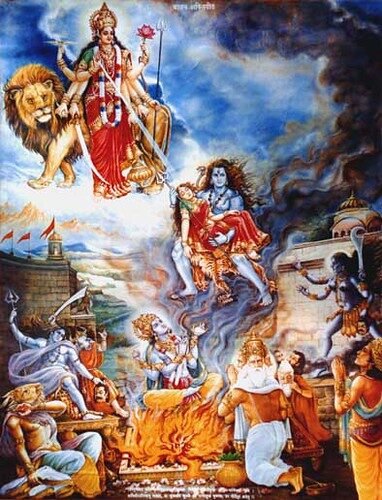
Heartbroken, Shiva lifted Sati’s charred body onto his shoulders and began his Tandava, the dance of destruction. His grief and fury threatened to destroy the cosmos. To prevent the world from being destroyed, Lord Vishnu intervened by using his Sudarshana Chakra to dismember Sati’s body into 51 (or sometimes 108) pieces. As Shiva wandered across the earth, these body parts fell at various locations, which later became the Shakti Peeths, sacred sites imbued with divine feminine energy.
Spiritual Importance
The story of Sati and Shiva not only explains the creation of these holy places but also serves as a symbolic narrative of divine love, sacrifice, and the eternal bond between Shakti (the feminine energy) and Shiva (the masculine consciousness). Shakti Peeths, thus, are embodiments of Shakti, the creative force of the universe, and represent the indestructible and all-pervading nature of divine feminine energy.
These temples are regarded as highly sacred in Hinduism, and visiting them is considered a form of intense spiritual practice. Each site holds unique rituals, festivals, and forms of worship that draw millions of devotees annually.
Significance of Shakti Peeths
Each of the Shakti Peeths represents a different part of Sati’s body and is associated with a specific manifestation of Goddess Shakti. The Shakti Peeths are not just places of worship; they symbolize the energy of the cosmos. Devotees believe that visiting these temples blesses them with divine energy, protection, and spiritual awakening. Each temple is linked to a unique form of Shakti, and worship at these sites is thought to fulfill wishes and bring inner peace. The male counterpart of the goddess (in the form of Bhairava, a manifestation of Lord Shiva) is also worshipped alongside her at these sites.
Locations of the 51 Shakti Peeths
Here is a comprehensive list of the 51 Shakti Peeths along with the temple names, the part of Sati’s body that is believed to have fallen there, and the form of Goddess Shakti worshipped at each location:
| Shakti Peetha | Temple Name | Part of Sati’s Body | Location | State/Country |
|---|---|---|---|---|
| 1. Kamakhya | Kamakhya Devi Temple | Yoni (Vulva) | Nilachal Hill, Guwahati | Assam, India |
| 2. Kankalitala | Kankaleshwari Temple | Pelvic Bone | Bolpur, Birbhum | West Bengal, India |
| 3. Tarapith | Tarapith Temple | Third Eye | Birbhum | West Bengal, India |
| 4. Kalighat | Kalighat Kali Temple | Right Toe | Kolkata | West Bengal, India |
| 5. Jwala Mukhi | Jwala Mukhi Temple | Tongue | Kangra Valley | Himachal Pradesh, India |
| 6. Vishalakshi | Vishalakshi Temple | Earring | Varanasi | Uttar Pradesh, India |
| 7. Ambaji | Ambaji Mata Temple | Heart | Ambaji, Banaskantha | Gujarat, India |
| 8. Bahula | Bahula Devi Temple | Left Arm | Ketugram, Katwa | West Bengal, India |
| 9. Naina Devi | Naina Devi Temple | Eyes | Bilaspur | Himachal Pradesh, India |
| 10. Dakshineswar | Dakshineswar Kali Temple | Right Toes | Kolkata | West Bengal, India |
| 11. Hinglaj | Hinglaj Mata Temple | Head | Hingol National Park, Balochistan | Pakistan |
| 12. Saptashrungi | Saptashrungi Temple | Right Arm | Vani, Nashik | Maharashtra, India |
| 13. Chamundeshwari | Chamundeshwari Temple | Hair | Mysore | Karnataka, India |
| 14. Ujjaini | Ujjaini Mahakali Temple | Elbow | Ujjain | Madhya Pradesh, India |
| 15. Manikyamba | Draksharamam Manikyamba Temple | Left Cheek | Draksharamam | Andhra Pradesh, India |
| 16. Sharada Peeth | Sharada Devi Temple | Right Hand | Neelum Valley, Kashmir | Pakistan-Administered Kashmir |
| 17. Kalmadhava | Kalmadhava Temple | Left Buttock | Amarkantak | Madhya Pradesh, India |
| 18. Mahalakshmi | Kolhapur Mahalakshmi Temple | Eyes | Kolhapur | Maharashtra, India |
| 19. Mahakali | Mahakali Temple | Right Hand | Ujjain | Madhya Pradesh, India |
| 20. Kamrup Kamakhya | Kamakhya Temple | Genitals | Guwahati | Assam, India |
| 21. Vaishno Devi | Vaishno Devi Temple | Right Hand | Trikuta Mountains | Jammu & Kashmir, India |
| 22. Jwalamukhi | Jwalamukhi Temple | Tongue | Kangra Valley | Himachal Pradesh, India |
| 23. Devi Patan | Devi Patan Temple | Right Shoulder | Tulsipur, Balrampur | Uttar Pradesh, India |
| 24. Sarvamangala | Sarvamangala Temple | Hair | Varanasi | Uttar Pradesh, India |
| 25. Shriparvata | Shriparvata Devi Temple | Right Ankle | Shrishailam | Andhra Pradesh, India |
| 26. Kamakshi | Kamakshi Amman Temple | Navel | Kanchipuram | Tamil Nadu, India |
| 27. Bhairavi | Bhairavi Temple | Left Leg | Kharagpur | West Bengal, India |
| 28. Girija Devi | Girija Devi Temple | Teeth | Jashore | Bangladesh |
| 29. Vimochana Devi | Vimochana Devi Temple | Waist | Mandi | Himachal Pradesh, India |
| 30. Manasa | Manasa Devi Temple | Right Knee | Haridwar | Uttarakhand, India |
| 31. Bhadrakali | Bhadrakali Temple | Ankles | Kurukshetra | Haryana, India |
| 32. Vikar Vasini | Vikar Vasini Devi Temple | Upper Lip | Dwarka | Gujarat, India |
| 33. Chhinnamastika | Chintpurni Devi Temple | Forehead | Una | Himachal Pradesh, India |
| 34. Sugandha Devi | Sugandha Devi Temple | Nose | Shikarpur | Bangladesh |
| 35. Lanka Peetha | Indrakshi Devi Temple | Anklet | Lanka Island | Sri Lanka |
| 36. Tripura Sundari | Tripura Sundari Temple | Right Leg | Tripura | Tripura, India |
| 37. Chhinnamastika | Chintpurni Devi Temple | Head | Himachal Pradesh | India |
| 38. Chamunda | Chamunda Devi Temple | Breast | Kangra Valley | Himachal Pradesh, India |
| 39. Jayanti Devi | Jayanti Devi Temple | Left Thigh | Aligarh | Uttar Pradesh, India |
| 40. Jogulamba | Jogulamba Temple | Upper Teeth | Alampur | Telangana, India |
| 41. Kalikambal | Kalikambal Temple | Back | Chennai | Tamil Nadu, India |
| 42. Vindhyavasini | Vindhyavasini Temple | Back | Vindhyachal | Uttar Pradesh, India |
| 43. Katyayani | Katyayani Temple | Lower Back | Vrindavan | Uttar Pradesh, India |
| 44. Sugandha Devi | Sugandha Devi Temple | Nose | Shikarpur | Bangladesh |
| 45. Shripur | Shripur Devi Temple | Right Leg | Bangladesh | Bangladesh |
| 46. Panchsagar | Panchsagar Temple | Teeth | Varanasi | Uttar Pradesh, India |
| 47. Ratnavali Devi | Ratnavali Temple | Anklet | Bengal | Bangladesh |
| 48. Kirit Shaktipeeth | Kirit Devi Temple | Crown | Murshidabad | West Bengal, India |
| 49. Srisailam | Bhramaramba Devi Temple | Throat | Andhra Pradesh | India |
| 50. Ujaani Devi | Ujaani Devi Temple | Forehead | Bengal | Bangladesh |
| 51. Gandaki Devi | Gandaki Devi Temple | Right Ankle | Nepal | Nepal |
| Shakti Peetha | Temple Name | Part of Sati’s Body | Location | State/Country |
|---|---|---|---|---|
| 1. Kamakhya | Kamakhya Devi Temple | Yoni (Vulva) | Nilachal Hill, Guwahati | Assam, India |
| 2. Kankalitala | Kankaleshwari Temple | Pelvic Bone | Bolpur, Birbhum | West Bengal, India |
| 3. Tarapith | Tarapith Temple | Third Eye | Birbhum | West Bengal, India |
| 4. Kalighat | Kalighat Kali Temple | Right Toe | Kolkata | West Bengal, India |
| 5. Jwala Mukhi | Jwala Mukhi Temple | Tongue | Kangra Valley | Himachal Pradesh, India |
| 6. Vishalakshi | Vishalakshi Temple | Earring | Varanasi | Uttar Pradesh, India |
| 7. Ambaji | Ambaji Mata Temple | Heart | Ambaji, Banaskantha | Gujarat, India |
| 8. Bahula | Bahula Devi Temple | Left Arm | Ketugram, Katwa | West Bengal, India |
| 9. Naina Devi | Naina Devi Temple | Eyes | Bilaspur | Himachal Pradesh, India |
| 10. Dakshineswar | Dakshineswar Kali Temple | Right Toes | Kolkata | West Bengal, India |
| 11. Hinglaj | Hinglaj Mata Temple | Head | Hingol National Park, Balochistan | Pakistan |
| 12. Saptashrungi | Saptashrungi Temple | Right Arm | Vani, Nashik | Maharashtra, India |
| 13. Chamundeshwari | Chamundeshwari Temple | Hair | Mysore | Karnataka, India |
| 14. Ujjaini | Ujjaini Mahakali Temple | Elbow | Ujjain | Madhya Pradesh, India |
| 15. Manikyamba | Draksharamam Manikyamba Temple | Left Cheek | Draksharamam | Andhra Pradesh, India |
| 16. Sharada Peeth | Sharada Devi Temple | Right Hand | Neelum Valley, Kashmir | Pakistan-Administered Kashmir |
| 17. Kalmadhava | Kalmadhava Temple | Left Buttock | Amarkantak | Madhya Pradesh, India |
| 18. Mahalakshmi | Kolhapur Mahalakshmi Temple | Eyes | Kolhapur | Maharashtra, India |
| 19. Mahakali | Mahakali Temple | Right Hand | Ujjain | Madhya Pradesh, India |
| 20. Kamrup Kamakhya | Kamakhya Temple | Genitals | Guwahati | Assam, India |
| 21. Vaishno Devi | Vaishno Devi Temple | Right Hand | Trikuta Mountains | Jammu & Kashmir, India |
| 22. Jwalamukhi | Jwalamukhi Temple | Tongue | Kangra Valley | Himachal Pradesh, India |
| 23. Devi Patan | Devi Patan Temple | Right Shoulder | Tulsipur, Balrampur | Uttar Pradesh, India |
| 24. Sarvamangala | Sarvamangala Temple | Hair | Varanasi | Uttar Pradesh, India |
| 25. Shriparvata | Shriparvata Devi Temple | Right Ankle | Shrishailam | Andhra Pradesh, India |
| 26. Kamakshi | Kamakshi Amman Temple | Navel | Kanchipuram | Tamil Nadu, India |
| 27. Bhairavi | Bhairavi Temple | Left Leg | Kharagpur | West Bengal, India |
| 28. Girija Devi | Girija Devi Temple | Teeth | Jashore | Bangladesh |
| 29. Vimochana Devi | Vimochana Devi Temple | Waist | Mandi | Himachal Pradesh, India |
| 30. Manasa | Manasa Devi Temple | Right Knee | Haridwar | Uttarakhand, India |
| 31. Bhadrakali | Bhadrakali Temple | Ankles | Kurukshetra | Haryana, India |
| 32. Vikar Vasini | Vikar Vasini Devi Temple | Upper Lip | Dwarka | Gujarat, India |
| 33. Chhinnamastika | Chintpurni Devi Temple | Forehead | Una | Himachal Pradesh, India |
| 34. Sugandha Devi | Sugandha Devi Temple | Nose | Shikarpur | Bangladesh |
| 35. Lanka Peetha | Indrakshi Devi Temple | Anklet | Lanka Island | Sri Lanka |
| 36. Tripura Sundari | Tripura Sundari Temple | Right Leg | Tripura | Tripura, India |
| 37. Chhinnamastika | Chintpurni Devi Temple | Head | Himachal Pradesh | India |
| 38. Chamunda | Chamunda Devi Temple | Breast | Kangra Valley | Himachal Pradesh, India |
| 39. Jayanti Devi | Jayanti Devi Temple | Left Thigh | Aligarh | Uttar Pradesh, India |
| 40. Jogulamba | Jogulamba Temple | Upper Teeth | Alampur | Telangana, India |
| 41. Kalikambal | Kalikambal Temple | Back | Chennai | Tamil Nadu, India |
| 42. Vindhyavasini | Vindhyavasini Temple | Back | Vindhyachal | Uttar Pradesh, India |
| 43. Katyayani | Katyayani Temple | Lower Back | Vrindavan | Uttar Pradesh, India |
| 44. Sugandha Devi | Sugandha Devi Temple | Nose | Shikarpur | Bangladesh |
| 45. Shripur | Shripur Devi Temple | Right Leg | Bangladesh | Bangladesh |
| 46. Panchsagar | Panchsagar Temple | Teeth | Varanasi | Uttar Pradesh, India |
| 47. Ratnavali Devi | Ratnavali Temple | Anklet | Bengal | Bangladesh |
| 48. Kirit Shaktipeeth | Kirit Devi Temple | Crown | Murshidabad | West Bengal, India |
| 49. Srisailam | Bhramaramba Devi Temple | Throat | Andhra Pradesh | India |
| 50. Ujaani Devi | Ujaani Devi Temple | Forehead | Bengal | Bangladesh |
| 51. Gandaki Devi | Gandaki Devi Temple | Right Ankle | Nepal | Nepal |
Festivals and Rituals at Shakti Peeths
The festivals and rituals at Shakti Peeths are grand celebrations of devotion and faith. Here are some of the most important practices:
- Navratri: The nine-day festival of Navratri, held twice a year, is one of the most significant celebrations at Shakti Peeths. It marks the victory of Goddess Durga over evil forces and includes fasting, singing hymns, and performing special rituals.
- Durga Puja: Celebrated primarily in West Bengal, Durga Puja is dedicated to the goddess Durga, one of the forms of Shakti. It involves elaborate ceremonies, idol worship, and community feasts.
- Aarti: Each day at Shakti Peeths begins and ends with an aarti (a devotional song) performed to honor the goddess. Devotees light lamps and offer flowers and food to the deity.
- Animal Sacrifice: In some Shakti Peeths, particularly in Eastern India and Nepal, animal sacrifice (typically goats) is performed during specific festivals like Navratri, as an offering to the goddess. However, this practice is controversial and has been banned in many regions.
- Kumari Puja: A special ritual performed during Durga Puja where young girls, symbolizing the goddess, are worshipped.
An embodiment of divine feminine energy
Shakti Peeths are an embodiment of divine feminine energy and offer a powerful spiritual experience to devotees. These temples not only hold religious importance but are also centers for festivals, rituals, and pilgrimages, especially during Navratri and Durga Puja. Visiting a Shakti Peeth is believed to purify the soul, bestow blessings, and connect one with the cosmic energy of the goddess Shakti.
From Sati’s tragic immolation to the scattering of her body across the earth, these temples serve as spiritual centers, preserving the memory of the Goddess and her cosmic role as the force behind creation and destruction.

